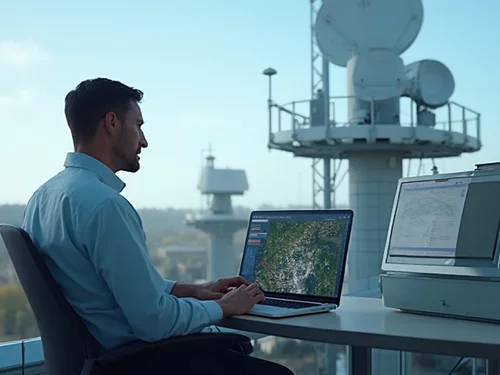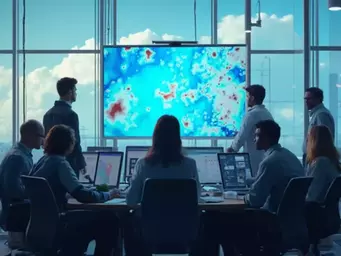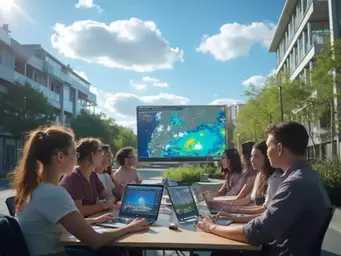Weather Science in Disaster Management: Forecasting for a Safer Future
Weather science is not just about predicting storms; it’s a lifeline for communities facing potential disasters. As we delve into the critical role of weather forecasting in disaster management, consider how technology and innovation are reshaping our response strategies.
What You Will Learn
- The significance of accurate weather forecasting in reducing disaster risks and saving lives.
- How technologies like IoT and big data enhance real-time weather analytics for better emergency preparedness.
- The impact of AI and machine learning on improving weather prediction accuracy and response times.
- The role of satellite imagery and radar in developing effective disaster response strategies.
- Understanding the influence of climate change on weather patterns and disaster management practices.
- Best practices for integrating weather science into community disaster preparedness initiatives.
- The importance of collaboration between emergency management agencies and NGOs in enhancing disaster response.
Key Technologies and Collaborations in Weather Science for Disaster Management
Weather science significantly contributes to disaster management through advanced forecasting, technological integration, and strategic partnerships. Below is a visual representation of the key elements driving this progress.
Key Technologies Enhancing Forecasting
- IoT and Big Data Integration
- AI and Machine Learning Advancements
- Satellite Imagery & Radar Technology
Innovations on the Horizon
- Enhanced Predictive Models
- Increased Use of Drones
- Blockchain for Data Integrity
- Community-Driven Data Collection
Best Practices in Forecasting
- Collaboration with Experts
- Regular Training & Workshops
- Public Education Campaigns
- Feedback Mechanisms
Collaboration Benefits
- Resource Sharing
- Coordinated Response Efforts
- Community Involvement
- Policy Advocacy
Understanding the Role of Weather Science in Disaster Management
Weather science plays a crucial role in disaster management, especially when it comes to reducing risks and enhancing emergency strategies. Accurate weather forecasting helps communities prepare for severe weather, ultimately saving lives and minimizing damage. I’ve seen firsthand how important these predictions are in ensuring that people have the information they need to stay safe.
Moreover, effective weather forecasting is not just about predicting storms; it's integral in developing emergency management strategies. For example, when meteorologists provide timely data about impending weather events, it allows emergency services to allocate resources efficiently and organize evacuations when necessary. The NOAA Science Report highlights how advancements in scientific understanding and technology are crucial for improving these forecasts and response systems.
The Importance of Weather Forecasting in Risk Reduction
- Improves early warning systems
- Enhances resource allocation during emergencies
- Informs public safety measures
Accurate forecasts bolster our ability to react quickly and effectively, making them vital for local governments and emergency services. By understanding weather patterns, leaders can issue timely warnings that help communities stay informed and prepared. The PCAST Extreme Weather Report further emphasizes the need for advanced forecasting to mitigate the impacts of increasingly frequent severe weather events.
Key Technologies Enhancing Weather Forecasting
Integrating IoT and Big Data in Weather Analytics
The integration of IoT devices and big data analytics is revolutionizing the way weather forecasting is done. These technologies allow us to collect vast amounts of data in real time, which improves forecasting accuracy and response times. For instance, IoT sensors can monitor environmental variables and provide valuable insights during disaster scenarios.
Imagine the difference it makes when emergency responders can access live data about changing conditions. It’s a game-changer in disaster management, providing a clearer picture of what to expect and how to act. By leveraging big data, meteorologists can analyze patterns that were previously hard to detect.
The Advancements of AI and Machine Learning
AI and machine learning are also making waves in weather prediction. These technologies can process massive datasets quickly, identifying correlations and patterns that human analysts might miss. This capability is not just theoretical; it is being applied in real-time disaster management across Australia.
Through AI, we can continuously refine our forecasting models, making them more responsive and accurate. This means when a severe weather event is on the horizon, we can provide timely and specific warnings to those affected, potentially saving countless lives!
The Role of Satellite Imagery and Radar Technology in Weather Forecasting
Satellite imagery and radar technology have significantly enhanced our ability to predict weather conditions. With high-resolution images and real-time radar data, meteorologists can observe weather systems as they develop. The NASA Disasters Program Annual Summary details how satellite data is critical for monitoring and responding to natural hazards globally.
This technology isn't just about tracking storms; it's about improving disaster response strategies. When emergency services have access to the best data available, they can plan more effectively for evacuations and resource distribution, ensuring community safety during critical times.
Understanding the Impact of Climate Change on Weather Patterns
Climate change is affecting weather patterns across the globe, and understanding these changes is essential for effective disaster management. As a meteorologist, I notice the increasing frequency and intensity of severe weather events, which have direct implications for forecasting and response strategies.
We need to consider how shifting climate patterns influence our predictions. By analyzing these trends, we can adapt our emergency management practices to better prepare for future events. It’s about being proactive rather than reactive!
Frequently Asked Questions (FAQs)
Q: Why is accurate weather forecasting so important for disaster management?
A: Accurate weather forecasting is crucial for reducing disaster risks, enhancing early warning systems, and allowing communities to prepare for severe weather, ultimately saving lives and minimizing damage.
Q: How do IoT and big data contribute to weather forecasting?
A: IoT devices and big data analytics enable the collection of vast amounts of real-time environmental data, which significantly improves forecasting accuracy and helps emergency responders make informed decisions during disaster scenarios.
Q: What role do AI and machine learning play in improving weather predictions?
A: AI and machine learning process massive datasets rapidly, identifying complex correlations and patterns that enhance the accuracy and responsiveness of forecasting models, leading to more timely and specific warnings.
Q: How do satellite imagery and radar technology improve disaster response?
A: Satellite imagery and radar provide high-resolution, real-time data on developing weather systems, allowing meteorologists to track storms and enabling emergency services to plan more effectively for evacuations and resource distribution.
Q: How does climate change affect disaster management practices?
A: Climate change leads to increased frequency and intensity of severe weather events, requiring disaster management practices to adapt through proactive analysis of shifting patterns and continuous refinement of emergency preparedness strategies.
We Want to Hear From You!
How do you feel about the advancements in weather science and their impact on disaster management? Share your thoughts below:
Future Directions for Weather Science in Disaster Management
The future of weather science holds exciting possibilities that can significantly enhance disaster management efforts. As we look ahead, advancements in technology, data analysis, and community engagement are poised to transform how we respond to and prepare for natural disasters. By integrating these innovations into our disaster management strategies, we can strive for more effective solutions and improved public safety.
Imagine a world where real-time data from various sources, including satellites and IoT devices, helps us predict weather patterns with unprecedented accuracy. This could lead to more timely evacuations and better resource allocation during critical situations. With such advancements on the horizon, the potential for improving disaster readiness is immense!
Innovations on the Horizon: Emerging Technologies
Emerging technologies are set to play a pivotal role in revolutionizing weather science and disaster management. Here are some potential advancements that could reshape our approaches:
- Enhanced Predictive Models: Utilizing machine learning to analyze vast amounts of historical weather data for improved forecasting accuracy.
- Increased Use of Drones: Deploying drones for real-time data collection and monitoring during disasters, providing critical information for emergency responders.
- Blockchain for Data Integrity: Ensuring data security and transparency through blockchain technology, enhancing trust in weather forecasts.
- Community-Driven Data Collection: Engaging communities in data-sharing initiatives to empower local decision-making in disaster preparedness.
These innovations not only promise to enhance forecasting capabilities but also aim to create a more resilient society that can better adapt to the challenges posed by climate change and severe weather events.
Encouraging Best Practices in Weather Forecasting
As we strive for advancements in weather forecasting, it's essential to adopt best practices that integrate weather science into disaster management effectively. Here are some key strategies to consider:
- Collaboration with Meteorological Experts: Engaging with meteorologists and researchers to ensure that forecasting techniques are based on the latest science.
- Regular Training and Workshops: Providing ongoing education for emergency management personnel on new forecasting tools and techniques.
- Public Education Campaigns: Increasing awareness around weather forecasting and its importance in disaster preparedness.
- Feedback Mechanisms: Establishing channels to receive input from the community on forecasting effectiveness and areas for improvement.
These practices are vital in fostering an environment of continuous improvement, ensuring that our disaster management strategies are both proactive and responsive to evolving weather patterns.
Collaboration Among Emergency Management Agencies and NGOs
The collaboration between emergency management agencies and non-governmental organizations (NGOs) is crucial in enhancing disaster preparedness and response efforts. By working together, these entities can share resources, expertise, and data to improve outcomes during disasters.
Partnerships can lead to:
- Resource Sharing: Pooling resources for training, equipment, and technology to enhance overall preparedness.
- Coordinated Response Efforts: Streamlining communication and decision-making processes during emergencies to ensure timely action.
- Community Involvement: Engaging local communities in disaster preparedness initiatives, making them active participants in enhancing safety.
- Policy Advocacy: Jointly advocating for policies that support funding and research in weather science and disaster management.
By leveraging the strengths of both sectors, we can create a more robust framework for weather-related disaster management, ultimately saving lives and protecting communities.
Recap of Key Points
Here is a quick recap of the important points discussed in the article:
- Accurate weather forecasting is essential for saving lives and minimizing damage during disasters.
- Integrating IoT and big data enhances forecasting accuracy and response times.
- AI and machine learning improve predictive models and allow for real-time data analysis.
- Satellite imagery and radar technology provide critical insights for emergency management.
- Understanding the impact of climate change is vital for adapting disaster management strategies.
- Collaboration among emergency services, NGOs, and communities fosters better preparedness and response efforts.
- Engaging the public through education and feedback is key to improving forecasting practices.










